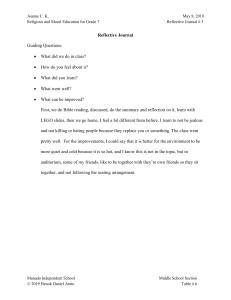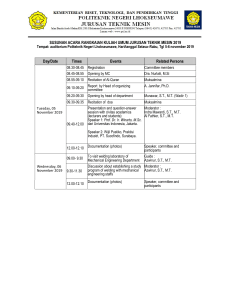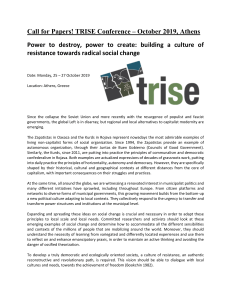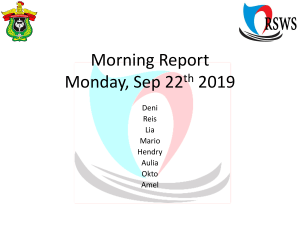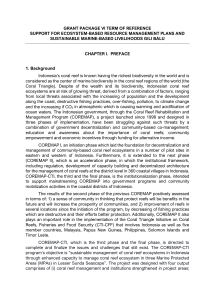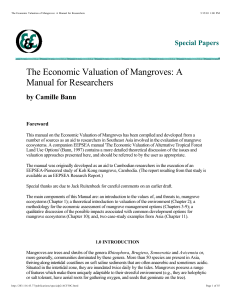Uploaded by
soekened
Density and Nutrient Content of Terebralia pallustris Mangrove Snails
advertisement
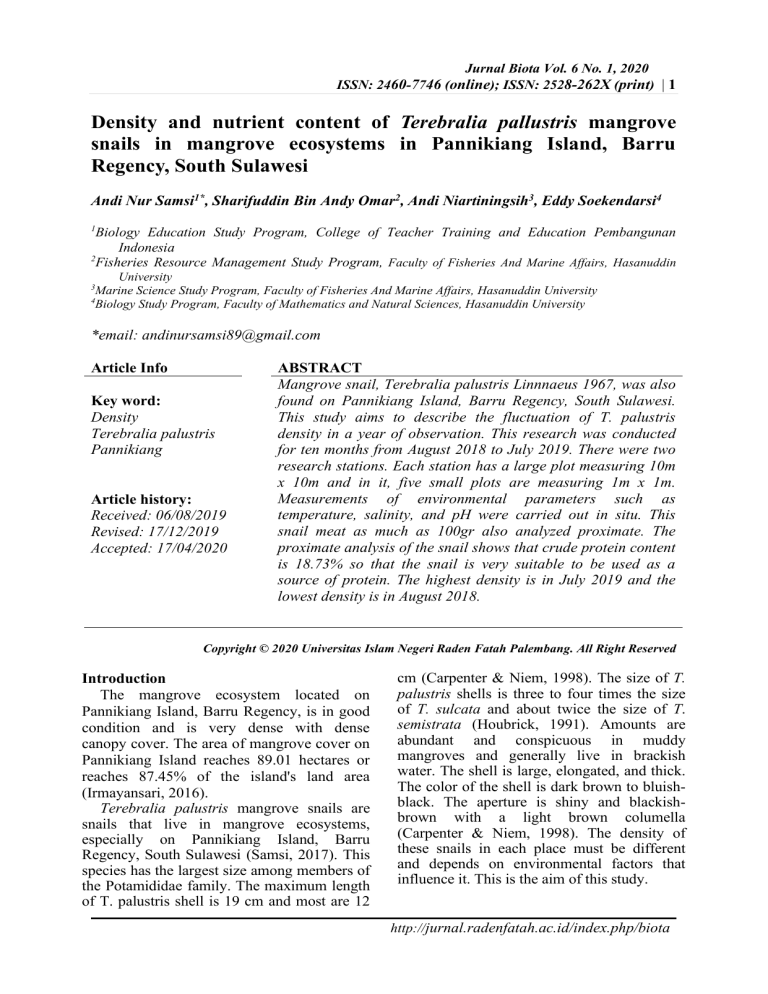
Jurnal Biota Vol. 6 No. 1, 2020 ISSN: 2460-7746 (online); ISSN: 2528-262X (print) | 1 Density and nutrient content of Terebralia pallustris mangrove snails in mangrove ecosystems in Pannikiang Island, Barru Regency, South Sulawesi Andi Nur Samsi1*, Sharifuddin Bin Andy Omar2, Andi Niartiningsih3, Eddy Soekendarsi4 1 Biology Education Study Program, College of Teacher Training and Education Pembangunan Indonesia 2 Fisheries Resource Management Study Program, Faculty of Fisheries And Marine Affairs, Hasanuddin University Marine Science Study Program, Faculty of Fisheries And Marine Affairs, Hasanuddin University 4 Biology Study Program, Faculty of Mathematics and Natural Sciences, Hasanuddin University 3 *email: [email protected] Article Info Key word: Density Terebralia palustris Pannikiang Article history: Received: 06/08/2019 Revised: 17/12/2019 Accepted: 17/04/2020 ABSTRACT Mangrove snail, Terebralia palustris Linnnaeus 1967, was also found on Pannikiang Island, Barru Regency, South Sulawesi. This study aims to describe the fluctuation of T. palustris density in a year of observation. This research was conducted for ten months from August 2018 to July 2019. There were two research stations. Each station has a large plot measuring 10m x 10m and in it, five small plots are measuring 1m x 1m. Measurements of environmental parameters such as temperature, salinity, and pH were carried out in situ. This snail meat as much as 100gr also analyzed proximate. The proximate analysis of the snail shows that crude protein content is 18.73% so that the snail is very suitable to be used as a source of protein. The highest density is in July 2019 and the lowest density is in August 2018. Copyright © 2020 Universitas Islam Negeri Raden Fatah Palembang. All Right Reserved Introduction The mangrove ecosystem located on Pannikiang Island, Barru Regency, is in good condition and is very dense with dense canopy cover. The area of mangrove cover on Pannikiang Island reaches 89.01 hectares or reaches 87.45% of the island's land area (Irmayansari, 2016). Terebralia palustris mangrove snails are snails that live in mangrove ecosystems, especially on Pannikiang Island, Barru Regency, South Sulawesi (Samsi, 2017). This species has the largest size among members of the Potamididae family. The maximum length of T. palustris shell is 19 cm and most are 12 cm (Carpenter & Niem, 1998). The size of T. palustris shells is three to four times the size of T. sulcata and about twice the size of T. semistrata (Houbrick, 1991). Amounts are abundant and conspicuous in muddy mangroves and generally live in brackish water. The shell is large, elongated, and thick. The color of the shell is dark brown to bluishblack. The aperture is shiny and blackishbrown with a light brown columella (Carpenter & Niem, 1998). The density of these snails in each place must be different and depends on environmental factors that influence it. This is the aim of this study. http://jurnal.radenfatah.ac.id/index.php/biota 2 | Jurnal Biota Vol. 6 No. 1, 2020 Agustu… Septe… Octobe… Novem… Februa… March'… April'19 May'19 June'19 July'19 Densities (ind/m2) Observation each month Figure 1. Average density of T. palustris every month June'19 30 20 10 0 April'19 Density is measured to find out how many individuals are in a certain area. Fratini, Vannini, Vigiani, & Cannicci (2004) found 10.5 ind m-2 T. palustris in Kenya's mangrove areas. Plaziat (1984) found T. palustris density of 150 ind m-2 while Slim et al. (1997) obtained a T. palustris density of 33 ind m-2 in the mangrove bay of Gazy Bay, Kenya. Patria & Putri (2017) found T. palustris density of 25 ind m-2 on Pulau Panjang, Banten. Febru… collection techniques and instrumental development Samples found for each plot are then put into the plastic. Observations and sample counts were carried out at the Laboratory of Fisheries Biology, Faculty of Fisheries and Maritime Affairs, Hasanuddin University. Proximate analysis was carried out at the Laboratory of Animal Food Chemistry, Faculty of Animal Science, Hasanuddin University. Measurement of environmental parameters (temperature, salinity, and pH of seawater) is done in-situ before sampling. Salinity is measured directly in the field using a hand-refractometer that has been previously rinsed with distilled water. 4. Data analysis techniques The density of T. palustris is calculated using the following formula (Brower, Zar, & Von Ende, 1990): n De = i A -2 Note De = density (ind m ), ni = total number of individuals, A = total area of the sampling 20.00 15.00 10.00 5.00 0.00 Octob… 3. Sample Results and Discussion a. Densities of Terebralia palustris Samsi (2014) found the average density of T. palustris in 2014 on Pannikiang Island at 24.6 ind m-2. Different results from 2018 to 2019 are an average density of 11.48 ind m-2. The highest average density was obtained in July 2019 and the lowest in August 2018 (Figure 1). Agust… 2. Population and samples The sample of this research is the T. palustris mangrove snail associated with mangroves. area, that is, the plot area (1 m x 1 m) multiplied by the number of replications (m2). Density (ind/m2) Materials and Methods 1. Research design This research was conducted in the mangrove ecosystem on Pannikiang Island, Barru Regency, South Sulawesi from August 2018 to July 2019. Sampling was not conducted in December 2018 and January 2019 due to weather constraints. The coordinate points at station A are 4˚20'23 "S and 119’36'11" E while at station B are 4˚21'37 "S and 119'35'42" E. In this study, two research stations were used. Station A is located in the northern part of the island and Station B is located in the southern part of the island. At each station, a plot of 10 m x 10 m was used and in this plot, there were small plots of 1 m x 1 m in a total of 5 units (Samsi, 2017). Station A Station B Observation every month Figure 2. The average density of T. palustris every month at stations A and B The density of T. palustris each month at stations A and B is different. The density of T. palustris at station A is higher than at station B (Figure 2).This is caused by several factors, namely the temperature of seawater, salinity of seawater, acidity of seawater, sediments and dominant plant species. http://jurnal.radenfatah.ac.id/index.php/biota 50 0 Ag… Oct… Fe… Ap… Jun… Temperature (Celcius) Jurnal Biota Vol. 6 No. 1, 2020 | 3 Station A Station B Observation each month June'… April'… Febr… Octo… 40 20 0 Agus… Salinity Figure 3. Measurement of sea water temperature every month Station A Station B Observation each month Figure 4. Measurement of seawater salinity every month The results of measurements of temperature and salinity of seawater at stations A and B show results that are not much different (Figures 3 and 4). However, slightly different results are shown in seawater acidity measurements at stations A and B (Figure 5). This striking difference can be seen from September 2018 to March 2019. b. The content of snails This snail is consumed by local residents as a source of protein. These snails are also consumed in Merauke (Pasaribu, Buyang, & Monika, 2019). Proximate analysis results show that in every 100 grams of mangrove snails it contains 67.84% water, crude protein 18.73%, crude fat 0.39%, crude fiber 0.16%, the ash content of 4.16 %, and Extraction Material without Nitrogen of 8.72%. Pasaribu et al. (2019) showed slightly different results, namely an average water content of 78.66%, an average protein of 28.68%, an average fat of 3.31%, and an average ash content of 28.13 %. The difference in the nutritional content of T. palustris snails is influenced by several factors, namely body weight, feed, length and shape of the shell (Ademolu, Idowu, Mafiana, & Osinowo, 2004), environmental factors, age of the snail, and even gender. Sources of protein and nitrogen (feed) will affect the nutritional content of snails (Ademolu et al., 2004; Emelue & Dododawa, 2017; Zhang et al., 2014). Some snails can be consumed and contain high nutrition. Engmann, Afoakwah, Darko, & Sefah (2013) found that Achatina achatina snails contained 82.96% protein, total carbohydrate 3.26%, and fat 3.98%. Babalola & Akinsoyinu (2009) found a crude protein content of 84.91% in Limicolaria sp., 79.28% in Achatina fulica, 75.28% in Achatina achatina, and 73.67% in Archachatina marginata. References Ademolu, K. O., Idowu, A. B., Mafiana, C. F., & Osinowo, O. A. (2004). Performance , proximate and mineral analyses of African giant land snail (Archachatina marginata) fed different nitrogen sources. African Journal of Biotechnology, 3(8), 412–417. Babalola, O. O., & Akinsoyinu, A. O. (2009). Proximate Composition and Mineral Profile of Snail Meat from Different Breeds of Land Snail in Nigeria Proximate Composition and Mineral Profile of Snail Meat from Different Breeds of Land Snail in Nigeria. Pakistan Journal of Nutrition, 8(1), 1–4. https://doi.org/10.3923/pjn.2009.1842.1 844 Brower, J. E., Zar, J. H., & Von Ende, C. N. (1990). Field and Laboratory Methods for General Ecology. Dubuque: Wm.C. Brown Publishers. Carpenter, K. E., & Niem, V. H. (Eds.). (1998). FAO species identification guide for fishery purpose. The living marine resources of the Western Central Pacific. Volume 1. Seaweeds, corals, bivalves and gastropods. Rome: FAO. Emelue, G. U., & Dododawa, Z. (2017). Nutritional Composition of African Giant Land Snail (Archachatina marginata) Fed on Diet from Different Protein Sources. Journal of Agriculture http://jurnal.radenfatah.ac.id/index.php/biota 4 | Jurnal Biota Vol. 6 No. 1, 2020 and Ecology Research International, 13(1), 1–7. https://doi.org/10.9734/JAERI/2017/33 927 Engmann, F. N., Afoakwah, N. A., Darko, P. O., & Sefah, W. (2013). Proximate and Mineral Composition of Snail (Achatina achatina) Meat ; Any Nutritional Justification for Acclaimed Health Benefits? Journal of Basic and Applied Scientific Research, 3(4), 8–15. Fratini, S., Vannini, M., Vigiani, S. F. Æ. V, & Cannicci, Æ. M. V. Æ. S. (2004). Terebralia palustris ( Gastropoda ; Potamididae ) in a Kenyan mangal : Size structure , distribution and impact on the ... Terebralia palustris ( Gastropoda ; Potamididae ) in a Kenyan mangal : size structure , distribution and impact on the consumption o, (May 2014). https://doi.org/10.1007/s00227003-1282-6 Houbrick, R. S. (1991). Systematic review and functional morphology of the mangrove snails Terebralia and Telescopium (Potamididae: Prosobranchia). Malacologia, 33(1–2), 289–338. Irmayansari, I. (2016, July 23). Pesona Hutan Mangrove Pulau Pannikiang Barru, Melihat Langsung Habitat Kelelawar. Tribun Barru. Pasaribu, Y. P., Buyang, Y., & Monika, N. S. (2019). Potential of mollusks from the coastal of Merauke as protein source for local community. IOP Conf. Series: Earth and Environmental Science, 235, 1–6. https://doi.org/10.1088/17551315/235/1/012064 Patria, M. P., & Putri, S. A. (2017). The role of Terebralia (Gastropoda: POtamididae) in carbon deposit at mangrove forest Pulau Panjang, Serang-Banten. In AIP Conference Proceedings (Vol. 40002, pp. 1–7). AIP Publishing. https://doi.org/10.1063/1.4983438 Plaziat, J. C. (1984). Mollusk Distribution in The Mangal. In P. D. and I. Dor (Ed.), Hydrobiology of The Mangal: The Ecosystem of The Mangrove Forests. Boston: W. Junk. Samsi, A. N. (2014). Pengaruh Faktor Lingkungan terhadap Pola Distribusi Moluska (Gastropoda dan Bivalvia) pada Ekosistem Mangrove Alami dan Hasil Rehabilitasi. Universitas Hasanuddin. Samsi, A. N. (2017). Derajat kemiripan ekosistem mangrove alami dan hasil rehabilitasi. Celebes Biodiversitas, I, 11–16. Retrieved from http://ojs.stkippi.ac.id/index.php/CB/art icle/view/93 Slim, F. J., Hemminga, M. A., Ochieng, C., Jannink, N. T., Cocheret De La Morinière, E., & Van Der Velde, G. (1997). Leaf litter removal by the snail Terebralia palustris (Linnaeus) and sesarmid crabs in an East African mangrove forest (Gazi Bay, Kenya). Journal of Experimental Marine Biology and Ecology, 215(1), 35–48. https://doi.org/10.1016/S00220981(97)00029-4 Zhang, Z.-W., Xu, X.-R., Sun, Y.-X., Yu, S., Chen, Y.-S., & Peng, J.-X. (2014). Heavy metal and organic contaminants in mangrove ecosystems of China: a review. Environmental Science and Pollution Research, 21(20), 11938– 11950. https://doi.org/10.1007/s11356014-3100-8 http://jurnal.radenfatah.ac.id/index.php/biota
